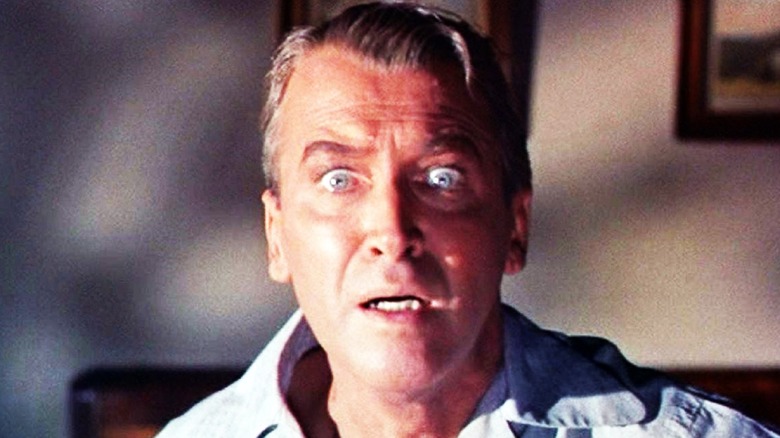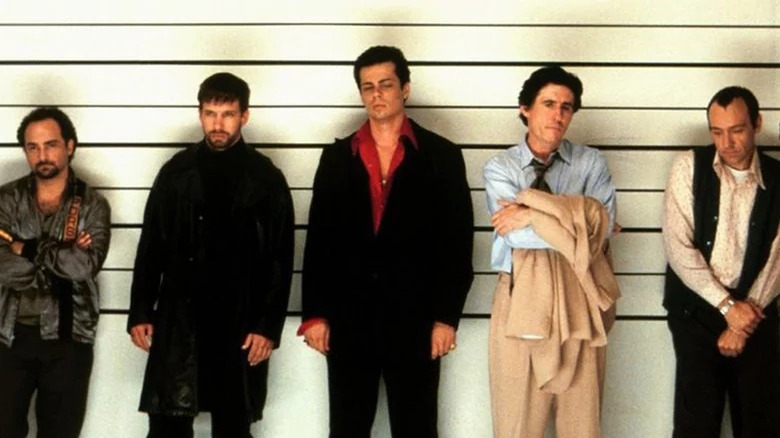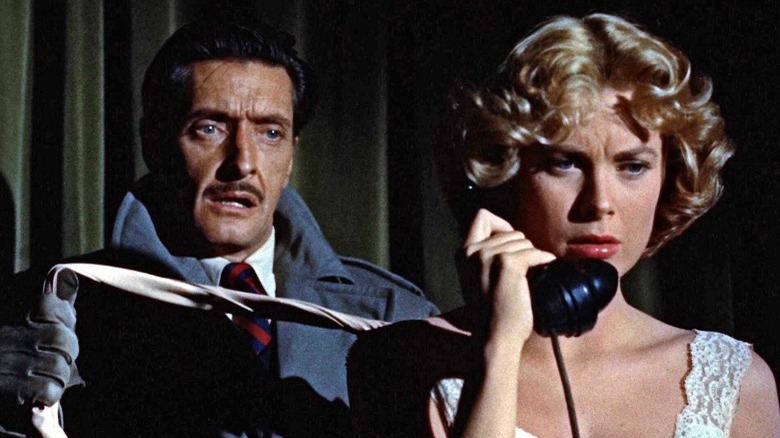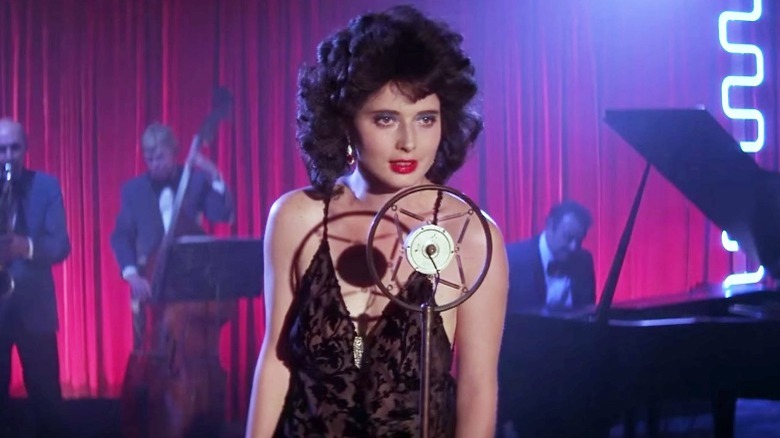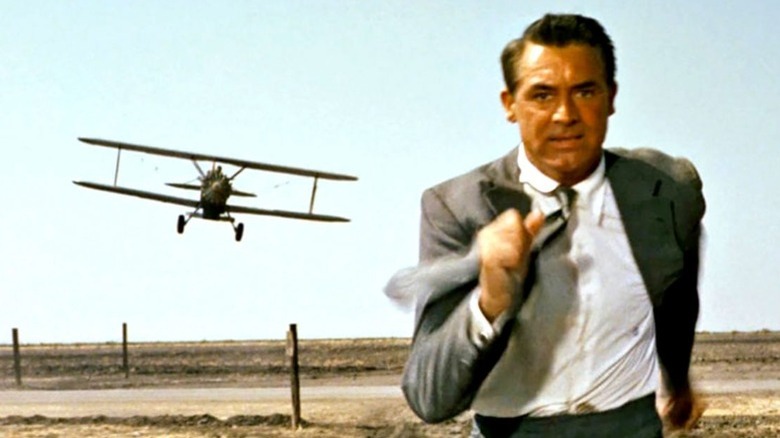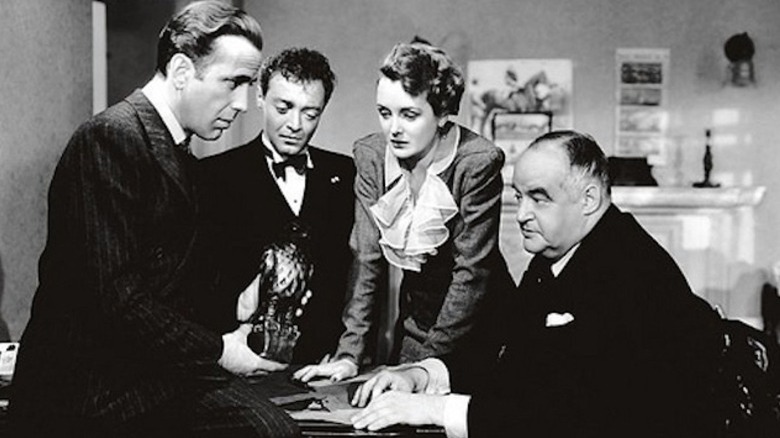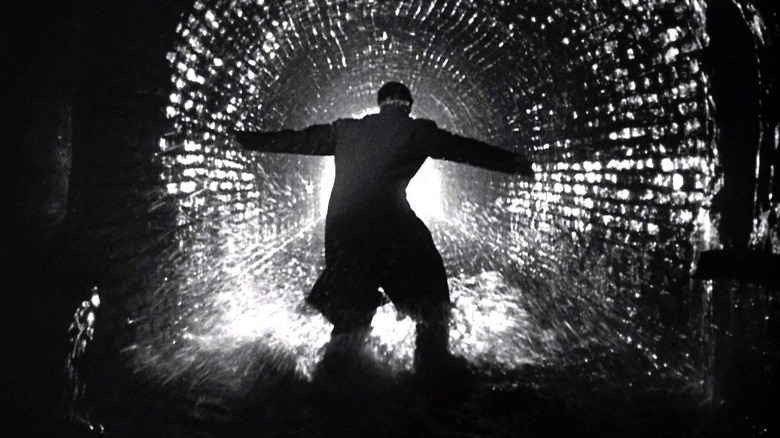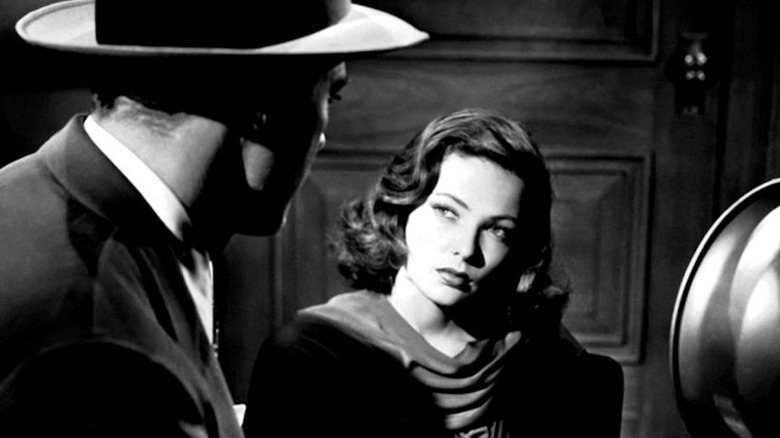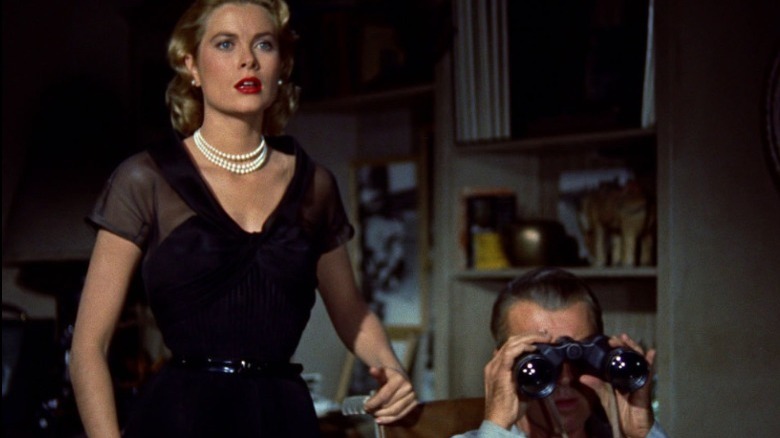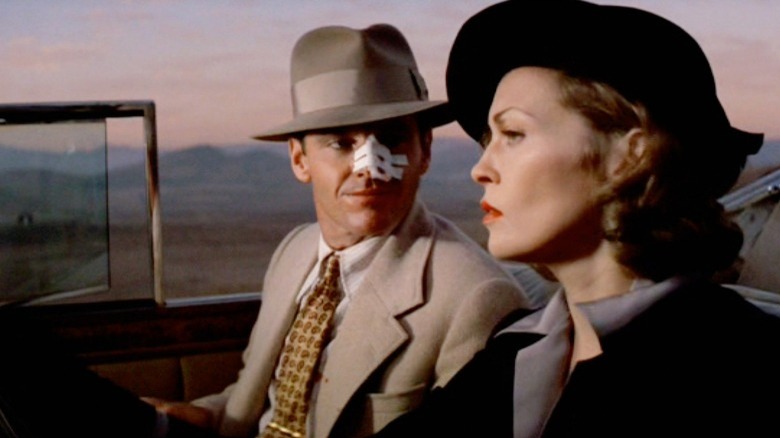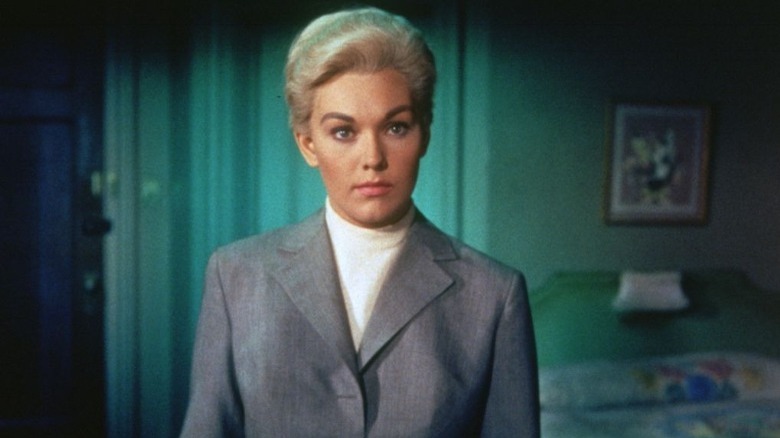The Top 10 Mystery Movies According To The AFI
Is there anything quite as thrilling as watching a good mystery? Whether it is a simple premise that leads to a shocking revelation, or a caper that delivers endless twists and turns, there's something endlessly delightful about watching secrets be unveiled on screen. Trying to figure out who's behind it all, whether it's one person, a group, or perhaps even nobody at all, guessing a film's secrets is a huge part of why mysteries are such successful films.
There are simply so many mystery films out there (and, let's be honest, just so many films out there!) that it can be super hard to choose one to watch that will be worth your time. The mystery genre has been going strong since the birth of cinema, and there are tons of fantastic mysteries out there to see. When it comes to the difficult decision of narrowing down the very finest mystery movies, The American Film Institute has helpfully created its own top 10 list.
The AFI defines the mystery genre as "a genre that revolves around the solution of a crime." Indeed, the AFI's selections, which span multiple decades and a multitude of thrills, all fit the bill, and they all center around investigations, whether from the police, a private eye, or something far more personal. Let's dive into the top 10 mystery movies according to the AFI.
The Usual Suspects
Who -– and where –- in the world is Keyser Söze? That's the overarching question and mystery that lies at the heart of the suspenseful and twisty mystery, "The Usual Suspects." The film, written by Christopher McQuarrie, who would go on to direct several "Mission: Impossible" films, largely peels back its layers through flashbacks and interrogation of Roger Kint (Kevin Spacey). Roger weaves a story of how five men rounded up as the usual suspects for a police lineup ended up working together to pull off an elaborate heist. The suspects are Dean (Gabriel Byrne), Michael (Stephen Baldwin), Fred (Benicio Del Toro), Todd (Kevin Pollak), and Verbal (Spacey).
After a massive explosion on a boat leaves 27 men dead, the cops try and find Söze, a criminal mastermind who holds extraordinary power, even though almost nobody has ever actually seen him. It appears that these five (not-so) usual suspects have connections to Söze, but what have they done, and why does he seem to be after them?
The film knows what it means to keep you guessing until the final moments, and McQuarrie's script sends audiences on a wild goose chase to try and uncover its mysteries. "The Usual Suspects" is best summarized by Spacey's character, who reminds audiences after the completely shocking final twist is laid bare, "The greatest trick the devil ever pulled was convincing the world he didn't exist."
Dial M for Murder
A wonderful dissection of a crime and the attempt to cover it up, Alfred Hitchcock's 1954 "Dial M For Murder" might be the most fun film on the list. That's not to say the movie isn't serious and chock-full of suspense, because it most certainly is, but "Dial M For Murder" definitely stands out from the rest of the list. Originally shot in 3D, when the technology was in its infancy, the film wastes almost no time setting things up and gets right to the mystery. In an affluent London suburb, Tony (Ray Milland) knows his wife Margot (Grace Kelly) is having an affair with American author Mark (Robert Cummings) and is preparing to leave him. However, as his wife is wealthy, he plans an elaborate plot to have her murdered so he can get her money.
This Hitchcock film is a surprising change of pace for the director. While many of Hitchock's movies often take great pleasure in building suspense, "Dial M for Murder" gives us the setup almost immediately and takes the vast majority of the film exploring the crime and its consequences. It's a blast to watch the detectives spar with Tony and Margot, and there's plenty of mystery and intrigue in the air, as Hitchcock has built a legendary career of keeping people guessing. Ordinary objects like keys and stockings hold immense meaning in the film, and it's a blast through and through to watch it all unfold.
Blue Velvet
Gleefully tearing the allure of suburbia with delicious malice, David Lynch's "Blue Velvet" is a horrifying, upsetting, grotesque, and delirious mystery. The film opens with beautiful clear blue skies, white picket fences, perfectly manicured flowers, smiling firefighters, children being helped along by crossing guards, all of which works together to establish a glorious, perfect suburban haven. However, that idyllic environment is quickly punctured by a man collapsing while watering his lawn. It appears not all is as charming as it seems in this affluent neighborhood, and that "Blue Velvet" is excited to unravel the secrets hiding in the sleepy town of Lumberton, North Carolina.
"Blue Velvet" encompasses a myriad of genres, feeling at times like a film noir, comedy, intense psychological horror, and drama, but the film is driven by a mystery, starting from when a college student (Kyle MacLachlan) finds a severed ear. What follows is a menacing cocktail of drugs, carnality, and shocking violence that's completely unpredictable. However, if you're familiar with David Lynch as a filmmaker, you'll know that's all par for the course. "Blue Velvet" is certainly the most divisive movie on the list, and like many Lynch films, you'll either love it or hate it. One thing's for sure — it's a compelling mystery that keeps you guessing, and there's not much else out there quite like "Blue Velvet."
North by Northwest
The ultimate quest of mistaken identities, "North by Northwest" is a fabulous romp from the unstoppable suspense king, Alfred Hitchcock.
While Hitchcock films often take place in a few locations, his 1959 film is a grand adventure. Everyday civilian Roger Thornhill (Cary Grant) is an advertising executive who gets mistaken to be George Kaplan, a powerful and hard-to-track secret agent working for the United States of America. He gets unwittingly kidnapped by foreign agents and interrogated by an enemy of the U.S., Phillip Vandamm (James Mason). All of the madness sends Thornhill on the run so he can prove his innocence and go back to his normal life. If only it were that simple -– on a train, he meets Eve Kendall (Eva Marie Saint), who graciously helps him escape the police. What feels like the end of Thornhill's troubles ends up just being the beginning, as Kendall turns out to be Vandamm's mistress.
What sets "North by Northwest" apart from so many other Hitchcock productions is that the film is a lot of fun and oozes with effortless cool, largely due to Grant's performance. He's an actor of incomparable suaveness, and it's not an exaggeration to say this film would be a lot less special without him. With a fantastic and exuberant score from world-class composer Bernard Herrmann and some tremendous set-pieces (Mount Rushmore has never been so thrilling), it's no wonder "North By Northwest" is on AFI's list of the greatest mystery films.
The Maltese Falcon
Few directorial debuts set a filmmaker up for a lifetime of success like John Huston's "The Maltese Falcon." The phenomenal 1941 noir is somehow Huston's first film, despite being an incredibly accomplished piece of filmmaking. It's no surprise Huston went on directing countless classics like "The Treasure on the Sierra Madre," "The African Queen," and "Beat the Devil," all of which starred Humphrey Bogart, making them one of the greatest actor-director partnerships of all time.
Things in "The Maltese Falcon" spiral out of control when Sam Spade (Bogart), a private investigator, takes on a case from Ruth Wonderley (Mary Astor), who needs Spade's help finding her missing sister. As things so often go in the world of noir, Spade gets a lot more than he bargained for by the case, which involves ruthless criminals and a classic femme fatale as they all seek an extremely valuable statue, the eponymous falcon. When everyone seems overwhelmed by greed and desire, things go off the rails as this terrific mystery works its magic.
As a director, Huston shows an impressive ability to draw fantastic performances from his cast. "The Maltese Falcon" features an astonishing turn from Mary Astor and brilliant supporting roles from Peter Lorre, Gladys George, Barton MacLane, and Sydney Greenstreet, who was nominated for an Oscar. While his performance in "Casablanca" really made Bogart a bonafide superstar, his electric, driven, and powerful performance in "The Maltese Falcon" may be his very best. Bogart's quick wit combined with hard-nosed detective prowess made an indelible impression on Hollywood. Quite simply, it was the stuff that dreams are made of.
The Third Man
An atmospheric wonder, Carol Reed's "The Third Man" comes in at number five on the AFI's top 10 mysteries. The film follows Holly Martins (Joseph Cotten), a writer who follows his best friend Harry Lime to Vienna, only to discover that Lime is dead. While there, he meets Anna (Alida Valli) and falls madly in love with her while they both mourn the loss of Lime, albeit for very different reasons.
Few cinematographers tell evocative stories with light quite like Robert Krasker, and the shadows playfully cloaking the Viennese streets are practically a character of their own. The film had an enormous impact in Austria, and there's even a Third Man Museum in the city. The Ferris Wheel, which is featured in one of the film's greatest scenes, and provided a legendary cinematic monologue, is still in the city, as the impact of "The Third Man" lives on.
For the first half of the film, the prevailing mystery of "The Third Man" is centered around Harry Lime (Orson Welles). When Lime finally appears, in one of cinema's greatest reveals, the mysteries become bigger, more dangerous, and totally thrilling. With Anton Karas' hugely memorable eclectic zither score fueling the shadowy Vienna streets, director Carol Reed creates a mesmerizing and brilliant experience. Reed brilliantly refuses to subtitle foreign languages, which helps audiences understand Martins' confusion as someone who only speaks English, one of the many reasons that "The Third Man" endures as one of cinema's greatest mysteries.
Laura
David Raskin's swooning, orchestral score brings us into Otto Preminger's 1944 noir masterwork "Laura." Like many great mysteries, the film begins with a police investigation that winds up getting far more complicated than anyone once thought. Detective Mark McPherson (Dana Andrews) is called in to investigate a murder –- of Laura Hunt (Gene Tierney), who has been shot to death in her own apartment.
McPherson interviews people that knew Laura to try and figure out who could be capable of such a shocking act, including speaking to her housekeeper Bessie (Dorothy Adams), her smarmy fiance (Clifton Webb), and her aunt Ann (Judith Anderson). McPherson begins to become enamored by the enigma of Laura, who has a massive portrait of herself hanging in her apartment, which McPherson studies intently. One night, he falls asleep in front of it and wakes up to a revelation that turns the case, and McPherson's world, upside down.
Director Otto Preminger is one of cinema's great masters, working across an array of genres, including courtroom dramas ("Anatomy of a Murder"), political thrillers ("Advise & Consent"), and musicals ("Carmen Jones"). There wasn't anything Preminger couldn't excel at, but he had a particularly tight grip on mysteries. "Laura" takes a straightforward approach and constantly challenges audiences' expectations, delivering plenty of shocks and a hugely interesting story full of fantastic music, great performances, and stunning revelations.
Rear Window
There's something undeniably compelling about the lives of those around you. Just what is it that your neighbors are doing in the privacy of their own homes? When professional photographer Jeff (James Stewart) is recuperating from a broken leg, he finds himself stuck in his apartment, with minimal entertainment to keep him busy, except, of course, for his trusty camera. With an ultra-long lens attached, Jeff begins peeking into the windows in the apartment complex and finds an awful lot more than he bargained for. One night, Jeff hears a scream –- "Don't!" –- and notices that following that event, a woman has disappeared from her apartment.
Hitchcock implements a masterful use of space in "Rear Window," his 1954 masterpiece that is amongst his finest work and ranks as the third greatest mystery on AFI's list. The film manages to both feel extremely claustrophobic and totally expansive, maximizing the use of Jeff's apartment to amazing effect. The film, which was inspired by real-life killings, features a brilliant, frenetic performance from Stewart, and great supporting turns from Grace Kelly and the always underappreciated Thelma Ritter.
Watching "Rear Window" unfold is hugely suspenseful, and Hitchcock proves once again that he can tell riveting, pulse-pounding stories in limited spaces. Having your heart beat out of its chest as "Rear Window" reaches its stunning conclusion is one of cinema's greatest joys.
Chinatown
There's something in the water — or rather, there is no water. Set near the arid and sticky California coast, "Chinatown" is inspired by a real-life water dispute between California cities duking it out over the siphoning of water from the Owens River, per The New York Times. The overwhelming heat permeates the world of private investigator Jake Gittes (Jack Nicholson), who is hired by an alluring woman, Evelyn Mulwray (Faye Dunaway), to track her husband Hollis (Darrell Zwerling), a prominent member of the Los Angeles Water Department.
Roman Polanski's mystery epic, "Chinatown," is deeply indebted to classic noir, all while making its mark as a classic of its very own. The film earned immense critical acclaim and commercial success that translated into an amazing 11 Oscar Nominations, though it only won for best original screenplay. Despite being overshadowed at the Oscars by films like "The Godfather Part 2" and "The Towering Inferno," the film has been able to shake that off over time, as the tangled and torrid world Gittes finds himself in is as exciting and suspenseful as cinema gets. There are plenty of brilliant performances in "Chinatown," with Nicholson, Dunaway, and John Huston shining especially bright.
Punctuated by Jerry Goldsmith's boozy score, the film comes alive with an intricate puzzle-box of a mystery and shocking revelations ("My sister! My daughter!"). What helps "Chinatown" feel unforgettable is its striking sense of pessimism. Robert Towne's Oscar-winning script refuses to find a neat conclusion, and the oft-quoted line, "Forget it, Jake, it's Chinatown," reminds us that justice isn't always carried out.
Vertigo
A lurid and scintillating tale of a relentless obsession, Alfred Hitchcock truly earned his moniker as the master of suspense with 1958's "Vertigo," the greatest mystery film of all time according to the AFI. It's not just the AFI who are wildly impressed with the film, and "Vertigo" has a reputation for being not just the greatest mystery of all time, but simply the greatest film of all time. In the prestigious Sight and Sound poll of the greatest films ever, "Vertigo" is at the very top, which is high praise as the survey accounts for hundreds of film critics.
On the fog-ridden streets of San Francisco, James Stewart stars as John "Scottie" Ferguson, a man whose acrophobia (fear of heights) ends his career as a police officer. Downtrodden after losing his job, Ferguson is hired as a private investigator to track down Madeleine (Kim Novak). He becomes utterly entranced, leading to an unhealthy, paranoia-drenched, highly dangerous obsession.
Hitchcock's film is as beautiful as it is unforgettable –- the film features some impressive innovations, including the first film to ever use the dolly zoom. "Vertigo" makes awe-inspiring use of color, including haunting green hues, and features iconic imagery, such as shots of San Francisco's Golden Gate Bridge. Lifted by Bernard Herrmann's lush, romantic score, "Vertigo" is full of secrets, and its sublime conclusion will lead you to come back to the film time and time again to unlock all of its mysteries.
